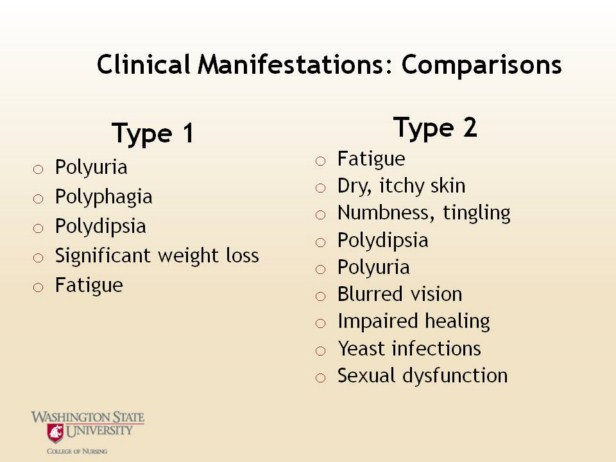| front |1 |2 |3 |4 |5 |6 |7 |8 |9 |10 |11 |12 |13 |14 |15 |16 |17 |18 |19 |20 |21 |22 |23 |24 |25 |26 |review |
 |
Clinical manifestations in Type 1 will present themselves over a shorter time frame. The clinical manifestations include:
1.Polyuria:
increased frequency of urination
2.Polyphagia:
Increased appetite
3.Polydipsia:
Frequent thirst
Clinical manifestations in Type 2 will appear over a long period of time and may be mistaken for other health problems and not diabetes.
●
1.Many people have
diabetes an average of 5-7 years before diagnosis
2.Since many people
with Type 2 are older, it is important to not just assume the symptoms
are because someone is elderly. It is important to talk to your
patients about the symptoms they are having and their risk factors.
3.Hyperglycemia causes
you to be fatigued.
4.Dry skin: Skin
provides an important defense mechanism against infection when it is
intact and healthy. Hyperglycemia resulting in polyuria may be a cause
of dehydration and subsequent dry skin. Anhidrosis, which is defined as
an autonomic neuropathic condition of diabetes in which little or no
perspiration is produced in the feet and legs, may lead to drying and
cracking of the skin. People with poorly controlled diabetes
complicated by vascular or neuropathic changes demonstrate an increased
risk for skin infection caused by staphylococci beta hemolytic
streptococci, and fungus.
5.Numbness and tingling
not only in feet, but hands/fingers.
6.Diabetes is the
number one cause of preventable blindness.
7.Increased blood sugar
interferes with the healing process.
8.Increased sugars also
cause yeast infections
9.Sexual dysfunction
can occur in both men and women as a clinical manifestation.
●
|